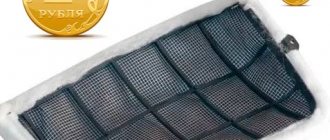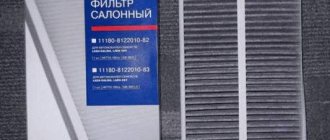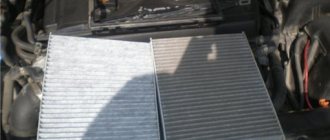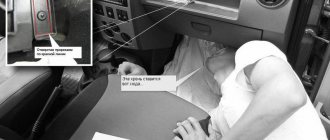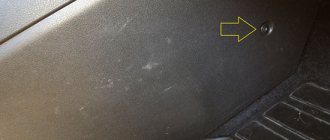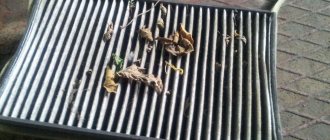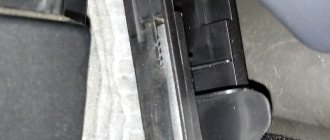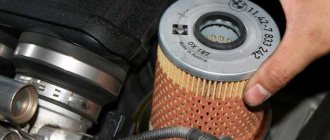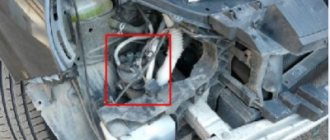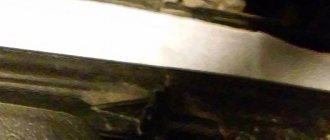It is extremely pleasant to sit in a clean car when you are driving. But the cleanliness of the upholstery and interior does not guarantee the cleanliness of the air entering through the heating system.
A special filter plays a big role in cleaning cabin air. Different filter elements are installed on different machines. But they are united by one common task.
If the filter uses up its resource, that is, stops fully performing the tasks assigned to it, this will negatively affect the quality of the air entering the machine. Polluted air will not do anything good in terms of health and well-being.
This raises a completely logical question regarding how to properly change the cabin filter and how often this should be done.
Cabin filter: a little history
The cabin cleaning system appeared much later than the air filter in its classic form. The number of vehicles increased rapidly, and the first traffic jams formed. Man was forced to come up with a way to protect himself from the negative effects of toxic substances.
The first paper cleaner was only 5.0 microns thick. The base was powerless against most toxins and gases. In the 90s, the purifiers were modernized. They looked like powerful, functional units and had activated carbon added to absorb air in the cabin.
All modern cars are equipped with standard air purifiers by default. Cheap cars have paper filters, while premium brands have carbon filters that neutralize all foreign odors.
By passing air currents through themselves, the filters trap microparticles of dirt. A process of gradual clogging occurs. The appearance of a foreign odor and weak air flow are the main signs of a malfunction.
We’ll look further at how to change the filter and what tools are needed for this.
Why is replacement carried out?
Not all motorists fully understand what the cabin filter installed in the car actually does and why change it. This is especially true for those drivers who are accustomed to operating old cars, where the filter is simply not provided for by the design of the car. And since it is not there, then supposedly the filter is not needed on other machines either.
Many people focus on the fact that particles, dust and microorganisms penetrating into the cabin, which are not retained by the filters due to their clogging or wear, are harmful to health. This is true. All such microparticles penetrate the human respiratory tract. They are dangerous even for healthy people, not to mention allergy sufferers.
Dust in the lungs not only causes coughing, but can also lead to the development of many diseases, including chronic illnesses. Therefore, it is recommended to clean the air on the way before entering the salon.
But this is not the only reason why the cabin filter should be changed as it wears out and becomes clogged.
- When dust and dirt pass through air ducts, it settles on internal surfaces. Such conditions become extremely favorable for the active reproduction of various bacteria. Legionella is considered one of the most dangerous. This is a bacterium that causes legionellosis in humans. Medical practice has proven that this is an extremely unpleasant infectious disease that affects people of any age.
- Polluted air often contains fairly large particles such as sand and dust. If they accumulate in the ventilation, heating and air conditioning systems, they will cause breakdowns over time. Due to dirt, electronics are destroyed, electric motors suffer, and various controls may fail. Considering the facts that modern cars are equipped with a large number of electronics and they are quite sensitive, it is extremely necessary to protect them from contamination.
- If dust and dirt, even in small quantities, reaches the interior, it gradually accumulates and settles on various surfaces, including glass. This negatively affects visibility. The upholstery on the seats and the clothes of the people inside also become dirty. If you change the filter on time, it guarantees that you will have to clean the interior and wash clothes much less often.
- The problem of foreign odors should not be ignored. Yes, even the highest quality carbon filters are not able to fully protect against them. But they perform at least partially this function. Therefore, the car will not be saturated with street odors. This is especially important when the car drives past landfills, various processing plants, burning fields, etc.
There are so many problems, and the solution is presented in the form of a small and very inexpensive element. Cabin filters are indeed among the cheapest consumable parts. But even this fact is sometimes not able to convey to the car owner the seriousness and importance of timely replacement of the filter element.
If you do not want to face respiratory problems, and also do not want to spend time and money on constant cleaning of the interior, it is much easier to buy a new filter, remove the old one and replace it yourself. This is an extremely simple procedure that can save your health and money.
Replacement frequency
It’s natural to now ask when it’s time to change the cabin filter in your car and how often to do it.
Everything here is directly related to the operating conditions of a particular vehicle. On average, automakers recommend replacing this consumable element every 20-25 thousand kilometers. If you want to know for sure, then you will have to open the instruction manual again. There are specific numbers for your car.
But the recommendations of automakers are very conditional. They do not always coincide with actual mileage. If your car is mainly used in urban environments, you often have to drive on dirt, in rural areas or on dusty roads, then no cabin filter will effectively last more than 10 thousand kilometers. The more contaminants in your path, the shorter the filter's service life. This is explained by the fact that when the roads are dusty, the filter elements begin to clog faster.
Many are guided not by mileage, but by purely personal feelings. When the car begins to smell strongly of dust, then motorists begin to replace it.
There are several signs that indicate the life of the cabin air filter is worn out. These include:
- the appearance of a persistent unpleasant odor inside the car;
- when the air conditioner is turned on at maximum power, it cools the interior poorly;
- When the stove is set to maximum mode, it does not heat strongly enough;
- glass often fogs up even with low humidity;
- There is a feeling of excess moisture inside the cabin.
Please note that the appearance of high humidity in the cabin is often associated with water getting directly onto the filter element itself. This is a typical weak point for domestic and Chinese cars. It’s just that in such machines the method of internal placement of the filter was not chosen entirely correctly.
If you had to operate the car in extreme conditions with a huge amount of dust, it is recommended not to delay, but to change the consumables as soon as possible. The same applies to situations where moisture accumulates in the filter. The element can no longer perform its cleansing functions.
Most often, moisture penetration is associated with clogging of channels, which are intended by the automaker to drain water from areas intended for air intake into the ventilation system. To prevent situations like this, be sure to clean your gutters periodically. Fallen leaves and other debris accumulate in them.
Why do you need a cabin filter in a car?
The main purpose of the component is to purify the air entering the car from outside. To fully capture the air flow, the machine is equipped with channels (sleeves) that capture the flow while moving.
The table shows substances that can affect the health of the driver and passengers, with their corresponding hazard classes:
The cleaning element helps filter the air coming from the air conditioning system. Models in the budget segment have integrated air supply and circulation channels.
But why do you need a filter if the doors are systematically opened, but there are still gaps at the joints? There is an explanation: the largest amount of toxic substances enters the cabin while driving, with a dense flow of traffic. The permissible limit is exceeded by 10 - 12 times; in the “quiet” state of the car the concentration is 3.0%. At such a concentration there is no threat to the human body or its respiratory system.
Introduction
Surely every driver has had to be stuck in a traffic jam at least once. And some even stand there for hours every day, caught up in the gigantic traffic. But rarely does anyone think that when driving or being stuck in a traffic jam, air from the environment enters the car, which is often very polluted. This could be dust, the unpleasant smell of exhaust fumes, pollen and many other nasty things. It is the cabin filter that prevents all this from getting into the car and, therefore, into the human body. However, most drivers are quite skeptical about this component of the car and do not consider it necessary to make a timely replacement. Some people use a car with a dirty filter, others occasionally wash it under water, dry it and put it back in place, and some people replace it.
The cabin filter prevents dust and gases from entering the car
Types of cabin filters
There are 2 types:
- Classic anti-dust.
- With coal filler.
The structure and design of dust filters allow them to clean the surface from impurities, dirt, soot, and allergens. The base is paper or a type of synthetic fiber. The filter traps particles no larger than 1.0 microns. Anything larger penetrates inside.
Five years ago, synthetic-based elements were improved. How has the cabin filter become better? It began to attract dust particles at the molecular level.
Carbon filters are called universal, but they also have difficulty retaining carbon monoxide. If the concentration is high, they are also powerless. The basis is a porous substance – activated carbon. The minimum granule size is 0.5 microns.
There are different types of paper cleaners, but they do not differ significantly from the classic paper and charcoal options.
Varieties
It’s hard to imagine now, but cabin air purifiers began to be installed on cars only in the early 90s of the last century. That is, they are not that many years old. Previously, drivers had to breathe what directly penetrated through the air intakes into the car.
At first, standard filters were used on almost all machines. They had minor differences. Gradually, the structure and design were changed, modified and modernized. This is how car enthusiasts became acquainted with two-layer filters, where one layer protected against large dust, and the second layer prevented the penetration of microparticles.
Later, more efficient carbon devices appeared on cars. Their special layer based on activated carbon managed to significantly improve the quality of air purification.
Modern cabin filters, depending on the cleaning principle used in them, are divided into 2 large groups:
- simple mechanical filters;
- adsorption, that is, carbon.
The mechanical elements consist of several barriers made of very thin fibers. Due to them, dirt does not penetrate inside.
Adsorption filters additionally contain activated carbon. It helps prevent harmful microorganisms and bacteria from entering the interior, and also eliminates unpleasant odors.
Where is the filter located?
The designs of air ducts, air intake systems, and vehicle cleaning elements vary. In recent years, there has been a tendency to standardize the shapes of units, including ventilation systems. A rectangular frame made of durable polymer material is a universal option.
A typical location is behind the glove box wall on the right side of the console. On some models there is a protective filter in the engine compartment, under the windshield, on the left side of the dashboard, at the rear of the engine.
Here's where the cabin air filter is located on popular models:
- Toyota Corolla: right side of the central dashboard.
- Chevrolet Cruze: also on the right side, but closer to the center of the console.
- DAEWOO Lanos: in the engine compartment, under the windshield on the right side.
Cost of professional services
Considering all the nuances of replacement, car owners think about the rationality of trying to do the work themselves. And then they want to know how much the procedure will cost if they change the cabin filter at a car service center.
The price depends on:
- the car itself;
- models;
- Year of release;
- filter location;
- type of filter element;
- complexity of work;
- service station pricing policy, etc.
It is difficult to name any specific amounts. Some may ask for their work from 500 rubles, others will say that the replacement alone will cost at least 2-4 thousand rubles, not counting the purchase of consumables and a filter.
Be prepared immediately for the fact that replacement from an official dealer will cost more. This is due to the use of only original, and therefore more expensive, spare parts. But their services give confidence in the quality of the work done. Plus you will definitely be given a guarantee. If suddenly the filter is replaced poorly or a defective part is supplied, you have every right to make a claim and demand that your mistakes be corrected free of charge. Official dealers are not interested in spoiling their reputation and that of the automaker. Therefore, problems rarely arise with them.
But third-party car services may ask you for money as for the original filter for your car, but they will supply some of the cheapest Chinese analogues. This does not happen everywhere, but the risks are higher. But the price for services is lower.
Regarding original spare parts. Cabin filters are not something complicated or incredibly expensive. Therefore, there are no significant differences between the originals and analogues. They produce approximately the same period of time and are able to effectively cope with air filtration.
Frankly cheap Chinese filters are not worth buying. And the problem here is not in the filter elements themselves, but rather in the frequent mismatch in size and fastenings. If you are willing to spend a normal amount on an original part, feel free to buy it. A worthy analogue can sometimes cost 2-3 times less. But it’s hardly possible to say that it will work worse. Now decide for yourself.
How to change the cabin filter?
Cleaning elements can be replaced yourself or in a workshop. To replace it yourself, you need minimal machine maintenance skills. You should not install components yourself on vehicles with a valid manufacturer’s warranty. With unprofessional intervention, there is a high probability of violation of the installation technology - because of this, the car will “fly off” the warranty. To reduce risks, it is better to entrust the work to service station professionals.
If you are determined to act on your own, but do not know how to remove the filter, read the instructions, technical recommendations, and watch video tutorials.
Should I buy a new one or make my own?
Making a new filter is a rather labor-intensive process. You need to buy a filter for a kitchen hood in the store, and then cut a fragment out of it. It should perfectly match the size of the old one. Then this fragment is pasted into the frame from the old one. Sealant or hot melt adhesive is used. The resulting filter can only handle dust.
To make a more effective carbon filter, you will need a regular padding polyester filter and a universal carbon filter. Don't forget about activated carbon. The tablets are placed between two pieces of filter material.
On the Internet you can find many options for making filters with your own hands, but you need to spend a sufficient amount of time on this. And it’s not a fact that you will get a quality product. A ready-made filter is not that expensive; it’s easier to buy it in a store.
Removing the cabin filter in the car
Let's look at the procedure for how to properly remove an element using the example of a car with a classic air system arrangement - on the right side of the console, behind the wall of the glove box.
On most cars, the box body is secured with plastic latches on the sides and two bolts at the bottom for added effect. Using a flat-tip screwdriver, pry up each of the clamps and unscrew the bolts. Access to the end part of the housing is provided. The protective cover is removed and the element itself is removed.
Installation location
Car manufacturers typically install cabin filters in three possible locations:
- under the hood - more precisely, near the partition of the engine compartment, access of medium complexity, usually cabinet options for curtains;
- near the glove box - behind the glove compartment or under it, easy access, both case and cartridge modifications are used;
- near the steering column - under the dashboard or on top of it, in the first case access is difficult, in the second it is easy, cartridge options are usually used;
Filter location under the hood
Cartridge behind glove compartment
Cartridge under dashboard
Unfortunately, when choosing a vehicle, the owner cannot predict the location of the cabin filter in advance. Since the performance of the machine is much more important than the maintenance of filtration equipment.
For example, in Chevrolet Lanos and ZAZ with a similar body, the cabin filter is conventionally located under the hood. However, getting to it is very difficult:
- you will have to dismantle 4 clips and remove half of the plastic air intake panel on the passenger side;
- pull out and remove another plastic part from the air intake hatch;
- climb onto the engine to reach the filter cover;
- remove it and carefully place the new product, inserting almost your entire arm up to the shoulder into the opening;
- install the water intake panel without damaging the left edge extending beyond the hood cover.
ZAZ and Lanos filter location
However, when located under the dashboard, the situation is even worse, which is why periodic replacement is not carried out by the owners.
How often should you change the cabin filter?
When to change the filter is determined by the manufacturer. According to established practice, the filter is changed every 30,000 km - that is, every second maintenance. The “unwritten” rules are followed in the EU and CIS countries. There is no need to change it often. If the surface of the filter is clean and there is no damage, it is not necessary to replace it - just blow it thoroughly with a stream of compressed air and put it back. This can be done no more than once.
Buy only original spare parts.
The owner himself should be interested in changing the filter in a timely manner, because we are talking about his health and comfort. If the car is driven in special conditions, when the level of gas and dust exceeds the permissible limits, reduce the replacement interval by a third. The manufacturer allows you to independently adjust the timing of replacement, but without causing harm to the car.
conclusions
From all of the above, we can draw an unambiguous conclusion: the cabin filter is a necessary component, the timely maintenance of which is the key to maintaining a pleasant atmosphere inside the car, eliminating the risk of minor ailments and serious diseases. When choosing an air purifier, you should pay attention to products from well-known brands that are in a higher price category. This is exactly the case when you can overpay and get obviously higher quality products that perform their functions many times better and at the same time maintain their functionality over a range of up to several tens of thousands of kilometers. When choosing between dust and carbon cabin filters, preference should be given to the latter, because they are more effective at resisting toxic substances.
